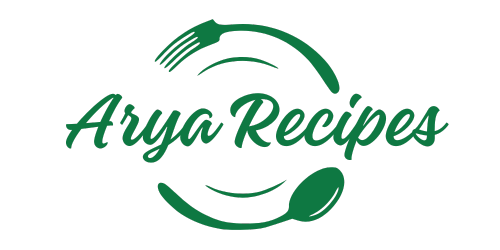Introduction
Oh boy, if there’s one dessert that screams nostalgia and indulgence in every bite, it’s butterscotch bars! These little golden beauties are the perfect mix of chewy, crunchy, buttery, and sweet—like a hug for your taste buds. If you’ve ever had a thing for peanut butter, marshmallows, and that deep caramelized flavor of butterscotch, you’re in for a real treat.
Butterscotch bars have been a staple in bake sales, potlucks, and cookie swaps for decades. There’s something about their rich, almost toffee-like sweetness that pairs so well with crispy rice cereal and gooey marshmallows. Oh, and let’s not forget the peanut butter crust—because, honestly, peanut butter makes everything better!
These bars are ridiculously easy to whip up, require zero fancy skills, and can be customized to your heart’s content. Whether you’re making them for a holiday party or just craving something sweet on a random Tuesday, this recipe has got your back. And trust me, once you taste them, you’ll wonder how you ever lived without them!
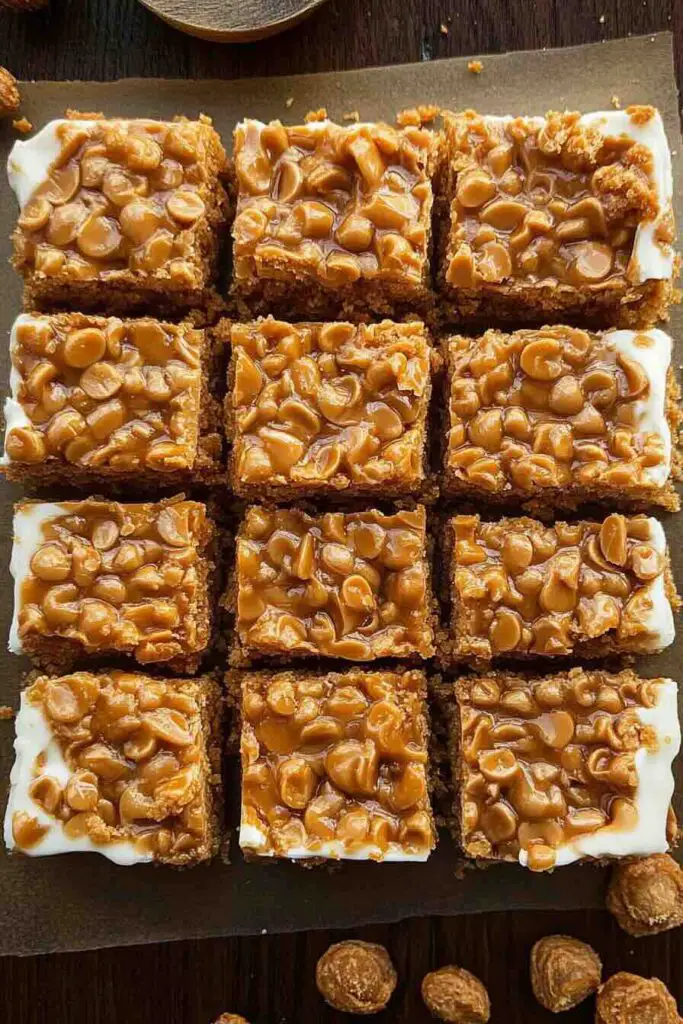
Reasons You’ll Love Butterscotch Bars
There are a million dessert bars out there, but butterscotch bars? They hit differently. Here’s why:
- Easy to Make – No complicated steps, no weird ingredients. Just mix, melt, layer, and let it set. Done!
- Perfect Texture – Chewy marshmallow, crunchy rice cereal, and a rich peanut butter base. Every bite is a dream.
- Crowd-Pleaser – These disappear FAST. Take them to a gathering, and watch them vanish.
- Customizable – Want to add chocolate? Go for it. More crunch? Throw in some nuts. These bars are ready for whatever twist you’re feeling.
What Makes a Good Butterscotch Bar?
Not all butterscotch bars are created equal. Some are too sweet, others fall apart at first bite, and some just don’t hit that perfect balance of flavors. So, what separates the best from the rest?
- Balanced Sweetness – Butterscotch is naturally rich, so the right amount of peanut butter and marshmallow ensures it’s indulgent but not cloying.
- Chewy Meets Crunchy – The best bars have a soft base, a gooey middle, and a crispy, slightly firm topping. It’s all about contrast.
- Deep Butterscotch Flavor – Using high-quality butterscotch chips (or making a butterscotch mixture from scratch) takes these bars from good to unforgettable.
- Well-Set Layers – Nobody wants a crumbly, falling-apart mess. The layers should stick together just enough to create a perfect bite.
The Cultural Significance of Butterscotch Bars
Butterscotch bars aren’t just another dessert—they have a long history of bringing people together. Whether it’s bake sales, Christmas cookie platters, or a sweet treat tucked into a lunchbox, they’ve been making people happy for generations.
- An American Classic – While butterscotch itself traces back to England, butterscotch bars are a homegrown American favorite, popping up in old-school church cookbooks and holiday spreads.
- A Link to Fudge & Caramel Treats – Butterscotch has always had a close relationship with caramel and toffee, making it a beloved base for desserts beyond just bars.
- Pure Nostalgia – If you grew up with a grandma who baked, chances are you’ve had some variation of these bars. They just taste like childhood, in the best way possible.
History of Butterscotch Bars
Where did butterscotch bars come from? Well, let’s take a little stroll down memory lane:
- The Origins of Butterscotch – The word “butterscotch” dates back to 19th-century England, where it referred to a hard candy made from butter and brown sugar.
- From Candy to Dessert – Over time, bakers realized that melting butterscotch into other ingredients created an irresistibly rich, buttery flavor.
- The Rice Cereal Revolution – The introduction of marshmallows and crispy rice cereal in American baking transformed these into the layered bars we know and love today.
Ingredients
Alright, let’s talk about what goes into these bars. Simple ingredients, BIG flavor.
For the Peanut Butter Crust:
- Creamy peanut butter
- Granulated sugar
- Egg
For the Marshmallow Layer:
- Mini marshmallows
For the Butterscotch Cereal Topping:
- Butterscotch chips
- Unsalted butter
- Light corn syrup
- Vanilla extract
- Crispy rice cereal
Equipment Needed
You don’t need much to make these, but having the right tools makes things easier.
- 9×13-inch baking dish – The perfect size for well-balanced layers.
- Parchment paper – Keeps the bars from sticking.
- Mixing bowls – For stirring everything together.
- Saucepan – To melt the butterscotch goodness.
- Spatula – For spreading and smoothing layers.
Step-by-Step Instructions
- Prepare the Baking Dish – Line with parchment paper.
- Make the Peanut Butter Crust – Mix peanut butter, sugar, and egg. Press into the pan and bake.
- Add the Marshmallow Layer – Sprinkle marshmallows on top and bake just until they puff.
- Melt the Butterscotch Mixture – Stir butterscotch chips, butter, and corn syrup until smooth.
- Combine with Cereal & Spread – Fold in the crispy rice cereal, then spread over the marshmallow layer.
- Let It Set – Cool completely before cutting into bars.
How to Tell When Butterscotch Bars Are Done
- Marshmallows should be puffy – Not melted into oblivion.
- Topping should be firm – If it’s still soft, give it more time to set.
- Edges should hold their shape – If they crumble, they’re too soft.
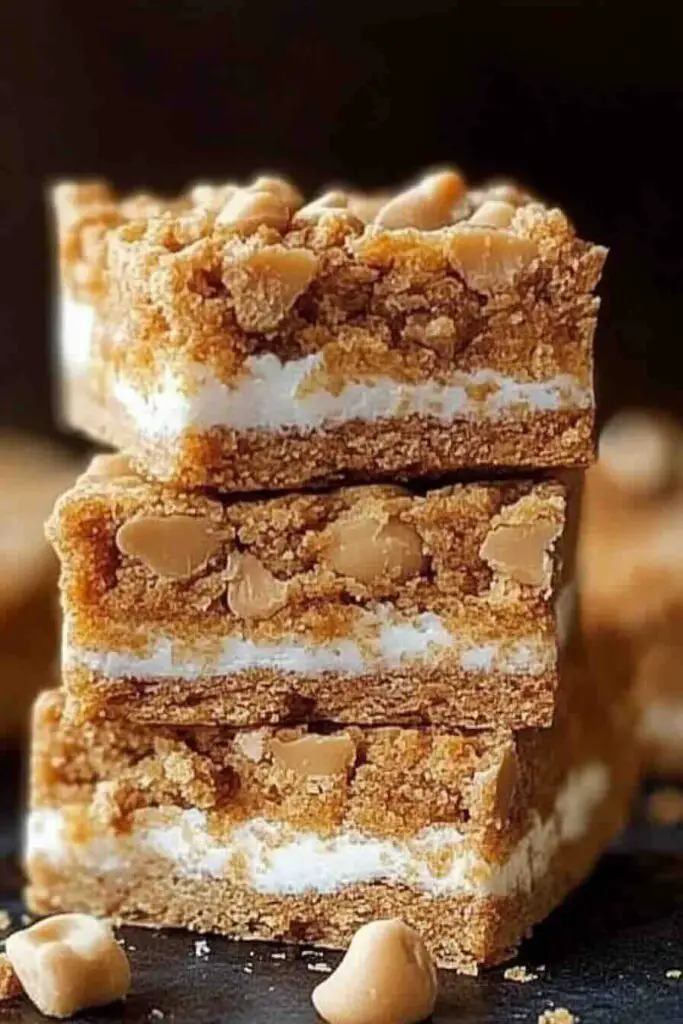
Variations & Toppings
One of the best things about butterscotch bars—aside from their addictive chewiness—is how versatile they are! You can tweak the ingredients, experiment with toppings, or even switch up the texture to make them truly your own. Whether you’re craving an extra layer of decadence, a salty contrast, or just want to use what you have in your pantry, here are some fantastic ways to customize your bars.
Add a Chocolate Drizzle for Extra Indulgence
If you’re the type who believes chocolate makes everything better (I see you!), adding a drizzle of melted chocolate on top takes these bars to another level. Simply melt semi-sweet, dark, or even white chocolate, then use a spoon or piping bag to drizzle it over the set bars before slicing. This not only adds visual appeal but also balances out the intense butterscotch sweetness with a deeper cocoa flavor.
Boost the Crunch with Nuts & Seeds
For those who love a little extra crunch, tossing in some chopped nuts is a no-brainer. Pecans, almonds, or walnuts add a lovely contrast to the chewiness of the marshmallow layer. If you’re looking for something a little different, pumpkin seeds or sunflower seeds work beautifully and add a subtle nuttiness without overpowering the butterscotch flavor.
Switch Up the Cereal for a Fun Twist
While crispy rice cereal is the classic choice, you don’t have to stick to tradition! Swap it out for cornflakes if you want a flakier, crunchier texture. Want a heartier feel? Try crushed graham crackers or granola. Even crushed pretzels can work if you’re in the mood for a sweet-and-salty combination that keeps you reaching for more.
Add a Salty Kick with Sea Salt
Speaking of sweet-and-salty, a sprinkle of flaky sea salt over the butterscotch topping is pure magic. That tiny pinch of salt enhances the buttery richness and prevents the bars from becoming overwhelmingly sweet. If you love salted caramel, you’ll definitely want to try this trick—it gives the same satisfying contrast of flavors.
Incorporate Spices for Warmth
If you want to add a little warmth and complexity to the bars, a pinch of cinnamon, nutmeg, or even a dash of pumpkin spice in the butterscotch mixture will do wonders. This is especially great for fall or holiday baking when cozy flavors take center stage.
Go Nut-Free for Allergy-Friendly Treats
Not a fan of peanut butter or dealing with allergies? No worries! You can substitute the peanut butter crust with a basic shortbread base or use a nut-free alternative like sunflower seed butter or tahini. It changes the flavor slightly but still provides that creamy richness that ties everything together.
Nutritional Insights
Alright, let’s talk about what’s actually in these bars—not just how delicious they are, but what they bring to the table nutritionally. While they’re definitely an indulgent treat, you might be surprised to learn that some of their ingredients offer more than just sweetness.
Caloric Breakdown
Each butterscotch bar comes in at around 274 calories, depending on portion size and ingredients used. The majority of these calories come from carbohydrates and fats, which makes sense given the sugar, peanut butter, and butterscotch chips involved. They’re rich, satisfying, and perfect for when you need a little energy boost.
Carbohydrates: The Sweet Foundation
Since the main ingredients include sugar, rice cereal, and marshmallows, it’s no surprise that these bars are high in carbohydrates. If you’re looking for a lower-carb version, you could experiment with sugar substitutes or a different type of cereal, but keep in mind that the classic texture relies on these components.
Fats: The Creamy, Buttery Goodness
Peanut butter and butter contribute to the fat content, making the bars rich and creamy. The fats in peanut butter, particularly, include healthy monounsaturated fats, which are good for heart health when consumed in moderation. If you’re aiming for a slightly healthier version, opting for natural peanut butter (with no added sugars or oils) is a great way to keep things a little more balanced.
Protein: A Small but Mighty Boost
Since peanut butter is one of the main ingredients, these bars contain a small amount of protein—more than your average dessert bar. While they won’t replace your post-workout snack, the protein from the peanut butter does help make them a bit more satisfying than a standard cookie or cake slice.
Ways to Reduce Sugar Without Losing Flavor
If you’re trying to cut back on sugar, here are some tricks:
- Use a lower-sugar cereal – Some rice cereals contain added sugars, so opt for a plain version if possible.
- Swap out the marshmallows – While this changes the traditional texture, you can reduce the amount of marshmallows or replace them with chopped dried fruit for natural sweetness.
- Use dark chocolate instead of butterscotch chips – If you love the general idea of these bars but want something less sweet, swapping out the butterscotch for dark chocolate chips makes a big difference.
Pro Tips & Tricks
Making butterscotch bars is pretty straightforward, but a few key tricks can take them from good to GREAT. Whether you’re a seasoned baker or just trying these for the first time, keep these tips in mind.
Prevent Butterscotch Chips from Seizing Up
If you’ve ever tried melting butterscotch chips and ended up with a clumpy, grainy mess, you’re not alone! These chips tend to seize up if they’re heated too quickly. The secret? Melt them low and slow. Use a double boiler or microwave them in short 15-second bursts, stirring in between, until smooth. Adding a teaspoon of butter or coconut oil can also help keep them silky.
Use Natural Peanut Butter with Caution
Natural peanut butter is great, but it has a tendency to separate, making it trickier to mix. If you’re using it, make sure it’s well-stirred before incorporating it into your recipe. If the texture is too runny, you might need to add an extra tablespoon of sugar to help it set properly.
Get Clean Slices Every Time
Nothing’s worse than slicing into a beautiful batch of bars only to end up with a sticky, crumbly mess. The trick? Use a warm knife. Run your knife under hot water, wipe it dry, then slice through the bars. This makes cutting through the marshmallow and butterscotch layers much smoother.
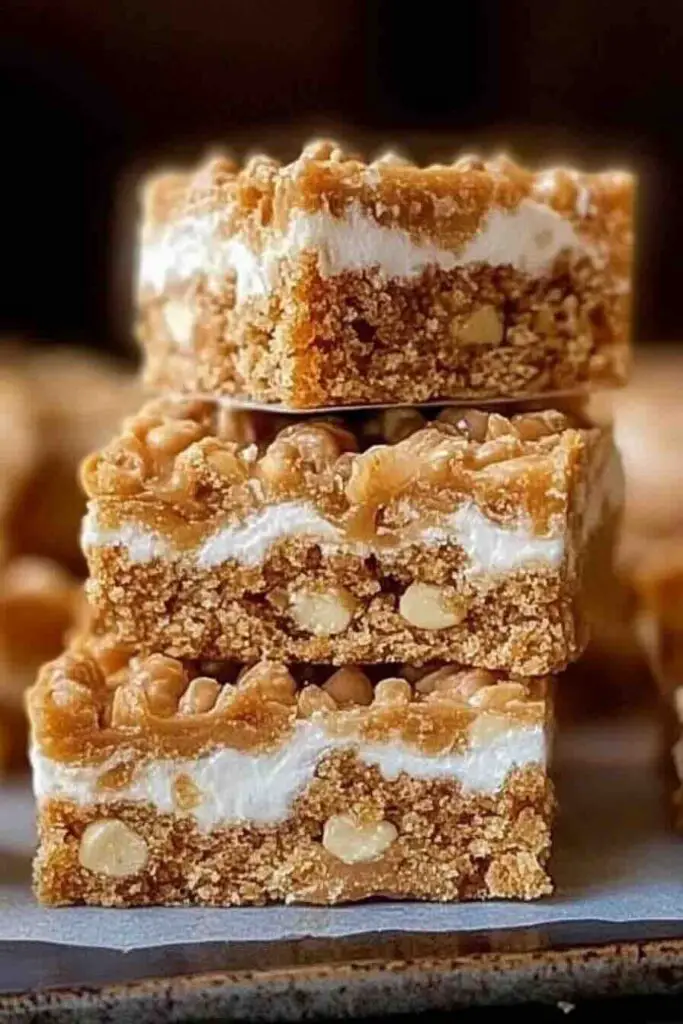
Storage & Health Tips
Keeping Butterscotch Bars Fresh
If you somehow manage to have leftovers (rare, but it happens!), proper storage is key to keeping them delicious.
- Room Temperature – Store them in an airtight container at room temp for up to 3 days.
- Refrigeration – If you want them to last longer, pop them in the fridge. They’ll stay good for up to a week, but let them sit out for a few minutes before eating so they’re not too hard.
- Freezing for Later – These bars freeze beautifully! Wrap them individually in plastic wrap, then place them in a freezer-safe bag. When you’re ready to enjoy, just thaw at room temp for 20–30 minutes.
Making a Healthier Version
If you’re looking to lighten these up a bit, try these swaps:
- Use almond butter instead of peanut butter for a slightly different (and often less sugary) base.
- Cut back on marshmallows or use a homemade version with less sugar.
- Try whole grain cereal instead of white rice cereal for a bit of added fiber.
FAQs About Butterscotch Bars
What’s the difference between butterscotch and caramel bars?
Caramel is made by cooking white sugar until it turns golden, while butterscotch uses brown sugar and butter. The result? Butterscotch has a deeper, more buttery flavor, while caramel leans slightly more burnt and toasty.
Is butterscotch made with actual Scotch?
Nope! Despite the name, butterscotch has nothing to do with Scotch whisky. It’s just a delightful mix of brown sugar and butter, sometimes with a little vanilla or cream.
What flavors pair best with butterscotch?
Chocolate, peanut butter, cinnamon, vanilla, and sea salt all complement butterscotch beautifully. It also works surprisingly well with toasted coconut or coffee-based flavors.
Can I make these gluten-free?
Yes! Just ensure your rice cereal and butterscotch chips are certified gluten-free, and you’re good to go.
Before You Go…
Try these bars, and let me know how you like them! And if you’re a butterscotch lover, you HAVE to check out my Cornmeal Pancakes recipe next—it’s next-level good!
Print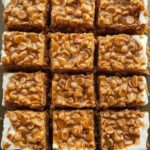
Butterscotch Bars
- Prep Time: 10 minutes
- Cook Time: 15 minutes
- Total Time: 25 minutes
- Yield: 12–16 bars 1x
Description
These butterscotch bars are an irresistibly chewy, crispy, and buttery dessert that combines peanut butter, butterscotch chips, and marshmallows in one delightful bite. With a simple prep and no fancy equipment needed, these bars are perfect for bake sales, potlucks, or just a quick homemade treat. The layers of creamy peanut butter, gooey marshmallows, and crunchy cereal create a texture that keeps you coming back for more!
Ingredients
Peanut Butter Crust:
- 1 cup creamy peanut butter
- ¾ cup granulated sugar
- 1 large egg
Marshmallow Layer:
- 3 cups mini marshmallows
Butterscotch Cereal Topping:
- 1½ cups butterscotch chips
- 2 tablespoons unsalted butter
- ¼ cup light corn syrup
- 1 teaspoon vanilla extract
- 3 cups crispy rice cereal
Instructions
- Preheat & Prepare: Preheat your oven to 350°F (175°C). Line a 9×13-inch baking dish with parchment paper.
- Make the Peanut Butter Crust: In a mixing bowl, combine peanut butter, sugar, and egg. Mix until smooth, then press evenly into the prepared baking dish.
- Bake the Crust: Bake for 12–14 minutes, or until the edges are lightly golden. Remove from oven.
- Add the Marshmallow Layer: Sprinkle the mini marshmallows evenly over the crust. Return to the oven for 2–3 minutes, just until the marshmallows puff up. Remove and let cool slightly.
- Melt the Butterscotch Mixture: In a saucepan over low heat, melt the butterscotch chips, butter, and corn syrup, stirring constantly. Once smooth, remove from heat and stir in vanilla extract.
- Combine with Cereal: Pour the melted butterscotch mixture over the crispy rice cereal in a separate bowl, stirring until fully coated.
- Assemble the Bars: Gently spread the butterscotch cereal mixture over the marshmallow layer, pressing lightly to ensure an even layer.
- Set & Slice: Let the bars cool completely at room temperature, or speed up the process by placing them in the fridge for 30 minutes. Once set, slice into squares and enjoy!
Notes
- For a nut-free version, substitute peanut butter with sunflower seed butter.
- If your butterscotch chips seize while melting, add a teaspoon of coconut oil for a smoother texture.
- A sprinkle of flaky sea salt on top enhances the flavor balance beautifully.
- Store at room temperature in an airtight container for up to 3 days or refrigerate for up to a week.
Nutrition
- Calories: 274
- Sugar: 27g
- Sodium: 98mg
- Fat: 12g
- Saturated Fat: 4g
- Carbohydrates: 38g
- Fiber: 1g
- Protein: 4g
- Cholesterol: 12mg
